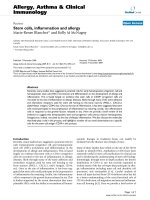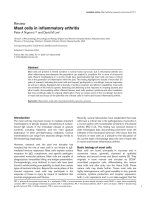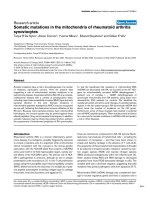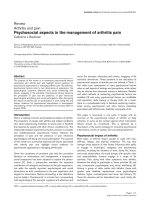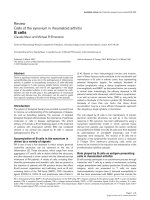Báo cáo y học: "Stem cells in the genomic age" docx
Bạn đang xem bản rút gọn của tài liệu. Xem và tải ngay bản đầy đủ của tài liệu tại đây (68.15 KB, 3 trang )
Genome Biology 2006, 7:315
comment
reviews
reports
deposited research
interactions
information
refereed research
Meeting report
Stem cells in the genomic age
Sally Lowell
Address: Centre for Development in Stem Cell Biology, Institute for Stem Cell Research, School of Biological Sciences, University of
Edinburgh, West Mains Road, Edinburgh EH9 3JQ, UK. Email:
Published: 22 May 2006
Genome Biology 2006, 7:315 (doi:10.1186/gb-2006-7-5-315)
The electronic version of this article is the complete one and can be
found online at />© 2006 BioMed Central Ltd
A report on the 2006 Joint Spring Meeting of the British
Society for Developmental Biology and the British Society
for Cell Biology, York, UK, 20-23 March 2006.
Stem cells span the divide between cell biology and develop-
mental biology, and so were an especially appropriate
subject for the recent joint meeting of the British Society for
Developmental Biology (BSDB) and the British Society for
Cell Biology (BSCB) this spring. Speakers from around the
world explored this fascinating topic from a wide variety of
perspectives and it was particularly interesting to see how
new and emerging technologies are being used to uncover
some of the mysteries of cell-fate determination.
A new look at old model systems
Cheryll Tickle (University of Dundee, UK) opened the
meeting by telling us that the chick, which has been a model
system for embryology since the time of Aristotle, is now
entering the genomic age. The chicken genome sequence was
published a year ago, and chick DNA microarrays are just
now becoming available. Tickle exemplified the power of
combining these new genetic tools with the more traditional
strengths of the chick embryo in the analysis of the sponta-
neous mutant Talpid3. Talpid3 protein appears to be
required specifically at sites of signaling by the Sonic hedge-
hog (Shh) protein, and experimental manipulation of Shh
availability confirms a failure to respond properly to Shh in
this mutant. Tickle outlined how Dave Burt and colleagues at
the Roslin Institute have isolated the Talpid3 gene by posi-
tional cloning but the sequence gives no real clue as to the
gene’s function. The mechanism by which Talpid3 interacts
with the Shh pathway is thus still under investigation.
The theme of using traditional model systems in novel ways
was continued by Ethan Bier (University of California at San
Diego, La Jolla, USA). The fruit fly Drosophila is a powerful
tool for genetic analysis that has revealed many general
principles of developmental patterning. Bier convinced us
that flies are also surprisingly efficient tools for understand-
ing the genetic basis of human disease. He pointed out that
of the 2,500 or so genes that have been linked to human dis-
eases, around three-quarters have counterparts in the fly. He
then described a myriad of ways in which flies can be
exploited to yield important insights into these diseases. For
example, a disease gene of unknown function can readily be
placed in a particular signaling pathway, such as those trig-
gered by Notch, Hedgehog, or transforming growth factor-,
thanks to the fact that mutations in the pathways give char-
acteristic phenotypes in the fly’s wing. He also explained
how standard screens for suppressors or enhancers could
identify the Drosophila equivalents of ‘human modifier loci’,
loci that give clues as to why particular human populations
are especially resistant, or susceptible, to certain diseases.
Stem-cell lineage commitment
Murine embryonic stem (ES) cells provide a powerful model
system. If we are to use these cells to investigate the mecha-
nisms of lineage commitment we need to be able to identify
and isolate cells at early commitment stages, and this is
often a major factor limiting progress in the field. Both
Gordon Keller (Mount Sinai School of Medicine, New York,
USA) and Shinichi Nishikawa (Riken Centre for Developmen-
tal Biology, Kobe, Japan) are tackling this problem by devel-
oping reporter cell lines in which fluorescent proteins or
cell-surface tags are expressed under the control of the regu-
latory elements of genes that mark first stages of early meso-
derm and endoderm differentiation. Keller used his genetic
reporters to show that the signal proteins activin and Wnt
cooperate in a dose-dependent manner to induce populations
of mesoderm or mesendoderm cells (mesendoderm can
develop into either mesoderm or endoderm)
. He then used
the same genetic markers to isolate these subpopulations and
succeeded in guiding their differentiation further using a
variety of growth factors to generate particular mesodermal
cell types such as blood, or endodermal cell types such
as liver.
Nishikawa also described an activin-based protocol for gen-
erating endoderm progenitors from ES cells, this time based
on monolayer culture of ES cells, rather than suspension
culture (suspension culture leads to the formation of cell
aggregrates called embryoid bodies). He reported the tran-
scriptional profiling of early endoderm and mesoderm popu-
lations, isolated using the genetic-reporter cell lines and
cell-surface markers developed in his group. This, he told us,
is just the beginning of an ambitious and far-reaching tran-
scriptional profiling project. As other labs around the world
develop reporter lines for their favorite cell types, Nishikawa
hopes to incorporate these into his analysis. The result will
be a huge database containing transcriptional profiles of
many cell types at different stages of differentiation and
commitment. Key regulators could then be identified accord-
ing to their characteristic expression profile. For example,
Arid3b has already been identified as a gene in mice that
becomes expressed as ES cells generate mesenchyme (loosely
organized tissue), and this gene also turns out to be required
for the generation of mesenchyme by neural crest cells.
Nishikawa’s group is developing optimized bioinformatic
tools for the formidable task of analyzing their ever-expand-
ing dataset, and also tools for relatively high-throughput
functional analysis of candidate gene regulators, such as a
retrovirus-delivered short hairpin RNA (shRNA) system for
RNA interference (RNAi). The power of this approach comes
from feeding back information from the microarray and
functional analysis to develop improved differentiation pro-
tocols and specification markers (Figure 1).
Reprogramming for pluripotency
Austin Smith (Institute for Stem Cell Research, Edinburgh,
UK) has developed similar genetic reporter lines for investi-
gating the question of how ES cells commit to the neural
lineage. He turned this question on its head by asking how
somatic cells such as neural stem cells can become repro-
grammed to a pluripotent ES-cell-like state (that is a state in
which they can give rise to all embryonic cell types). Although
we know that somatic nuclei can become reprogrammed
when transferred into an oocyte or fused with an ES cell, the
underlying mechanisms remain obscure. Using the ES fusion
system, Smith has found an unexpected role for the homeo-
domain-containing protein Nanog in this process. By boost-
ing levels of Nanog it is possible to increase the efficiency of
nuclear reprogramming up to 100-fold in cell fusions
between ES cells and neural stem cells, and further experi-
ments demonstrate that Nanog is in fact a key limiting factor
for establishment of pluripotency in cell hybrids.
Takashi Shinohara (University of Kyoto, Japan) continued
with the theme of reacquiring pluripotency. Some years ago he
developed methods for long-term culture of spermatogonial
cells that can generate functional sperm after transplantation
into mouse testis. These cells are normally restricted to sper-
matogenesis but Shinohara observed that occasionally they
give rise in culture to a pluripotent cell type that could con-
tribute to germline chimeras after transplantation into a
mouse blastocyst, and so can be considered to be equivalent
to a blastocyst-derived ES cell. He reported that these
pluripotent cells can be derived at low frequency from
neonatal spermatogonial cultures of wild-type mice, and that
this frequency is significantly increased in a p53-mutant
background.
One key difference between germ cells and ES cells is their
epigenetic imprint status. Shinohara reported that while the
spermatagonial cells retain a stable androgenic imprint over
long-term culture, the pluripotent cells derived from them
have a somewhat less stable imprint. They do, however, still
retain some germline-specific imprinting. So far, this is the
only discernable difference between the germline-derived
pluripotent cells and blastocyst-derived pluripotent cells and
it will be interesting to explore its implications, if any. One of
the practical consequences of the culture and clonal selec-
tion of spermatogonical cells is that it allows for the genera-
tion of gene-targeted offspring without using ES cells. Rats
are a much better model system than mice in certain fields,
particularly neuroscience, and progress has been greatly
hampered by our inability to derive rat ES cells. Shinohara
hinted that he was making progress in applying his findings
to the rat.
Finally, Tariq Enver (University of Oxford, UK) described a
mathematical model, developed in collaboration with Sui
Huang (Harvard University, Boston, USA), which explains
how cross-repression and autoregulation of key transcrip-
tion factors could maintain a stable stem-cell-type state. He
has also carried out microarray analysis of hematopoietic
315.2 Genome Biology 2006, Volume 7, Issue 5, Article 315 Lowell />Genome Biology 2006, 7:315
Figure 1
An iterative approach to investigating the mechanisms of lineage
specification of ES cells. Information obtained from functional studies and
microarray analysis can be used to identify specification markers and
improve differentiation protocols.
ES cell culture
Defined culture conditions
Markers for lineage commitment
Gene evaluation
RNA interference
Gene discovery
Microarray analysis
comparing different lineage-
committed populations
stem cells, following the changes in their transcriptional
profile as they escape from the stem-cell state and commit to
differentiation. When two cells chose different fates they
must of course diverge at some point in their transcriptional
profile, but, interestingly, Enver found that this does not
happen immediately - they initially travel together, undergo-
ing the same transcriptional changes for the first 24 hours.
This implies that there is a common transcriptional program
for ‘loss of potency’ that can be uncoupled from lineage-
specific differentiation programs. One gene, Nov, which is
downregulated as cells journey towards commitment, was
functionally tested through gain- and loss-of-function, and
did indeed fit the criteria of a key regulator of the undifferen-
tiated stem-cell state.
Developmental biology and cell biology have been trans-
formed in recent years, not only by new technologies but also
by the creativity with which these powerful tools have been
used. As the pace continues to increase, we can look forward
to exciting times ahead.
Acknowledgements
I thank Cheryll Tickle, Tariq Enver and Austin Smith for comments on the
manuscript. I also thank the BSDB for providing me with a travel grant
towards the cost of attending this meeting.
comment
reviews
reports
deposited research
interactions
information
refereed research
Genome Biology 2006, Volume 7, Issue 5 Article 315 Lowell 315.3
Genome Biology 2006, 7:315


